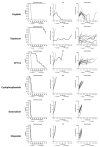Establishment and characterization of the first pediatric adrenocortical carcinoma xenograft model identifies topotecan as a potential chemotherapeutic agent
- PMID: 23406775
- PMCID: PMC3618554
- DOI: 10.1158/1078-0432.CCR-12-3354
Establishment and characterization of the first pediatric adrenocortical carcinoma xenograft model identifies topotecan as a potential chemotherapeutic agent
Abstract
Purpose: Pediatric adrenocortical carcinoma (ACC) is a rare and highly aggressive malignancy. Conventional chemotherapeutic agents have shown limited utility and are largely ineffective in treating children with advanced ACC. The lack of cell lines and animal models of pediatric ACC has hampered the development of new therapies. Here we report the establishment of the first pediatric ACC xenograft model and the characterization of its sensitivity to selected chemotherapeutic agents.
Experimental design: A tumor from an 11-year-old boy with previously untreated ACC was established as a subcutaneous xenograft in immunocompromised CB17 scid(-/-) mice. The patient harbored a germline TP53 G245C mutation, and the primary tumor showed loss of heterozygosity with retention of the mutated TP53 allele. Histopathology, DNA fingerprinting, gene expression profiling, and biochemical analyses of the xenograft were conducted and compared with the primary tumor and normal adrenal cortex. The second endpoint was to assess the preliminary antitumor activity of selected chemotherapeutic agents.
Results: The xenograft maintained the histopathologic and molecular features of the primary tumor. Screening the xenograft for drug responsiveness showed that cisplatin had a potent antitumor effect. However, etoposide, doxorubicin, and a panel of other common cancer drugs had little or no antitumor activity, with the exception of topotecan, which was found to significantly inhibit tumor growth. Consistent with these preclinical findings, topotecan as a single agent in a child with relapsed ACC resulted in disease stabilization.
Conclusion: Our study established a novel TP53-associated pediatric ACC xenograft and identified topotecan as a potentially effective agent for treating children with this disease.
©2013 AACR.
Figures




Similar articles
-
Update on in-vivo preclinical research models in adrenocortical carcinoma.Curr Opin Endocrinol Diabetes Obes. 2020 Jun;27(3):170-176. doi: 10.1097/MED.0000000000000543. Curr Opin Endocrinol Diabetes Obes. 2020. PMID: 32304391 Free PMC article. Review.
-
Targeting heterogeneity of adrenocortical carcinoma: Evaluation and extension of preclinical tumor models to improve clinical translation.Oncotarget. 2016 Nov 29;7(48):79292-79304. doi: 10.18632/oncotarget.12685. Oncotarget. 2016. PMID: 27764813 Free PMC article.
-
Rottlerin as a novel chemotherapy agent for adrenocortical carcinoma.Oncotarget. 2017 Apr 4;8(14):22825-22834. doi: 10.18632/oncotarget.15221. Oncotarget. 2017. PMID: 28423559 Free PMC article.
-
Preclinical targeting of the type I insulin-like growth factor receptor in adrenocortical carcinoma.J Clin Endocrinol Metab. 2009 Jan;94(1):204-12. doi: 10.1210/jc.2008-1456. Epub 2008 Oct 14. J Clin Endocrinol Metab. 2009. PMID: 18854392 Free PMC article.
-
Xenograft models for preclinical drug testing: implications for adrenocortical cancer.Mol Cell Endocrinol. 2012 Mar 31;351(1):71-7. doi: 10.1016/j.mce.2011.09.043. Epub 2011 Oct 26. Mol Cell Endocrinol. 2012. PMID: 22056412 Review.
Cited by
-
Network analysis reveals potential markers for pediatric adrenocortical carcinoma.Onco Targets Ther. 2016 Jul 26;9:4569-81. doi: 10.2147/OTT.S108485. eCollection 2016. Onco Targets Ther. 2016. PMID: 27555782 Free PMC article.
-
Update on in-vivo preclinical research models in adrenocortical carcinoma.Curr Opin Endocrinol Diabetes Obes. 2020 Jun;27(3):170-176. doi: 10.1097/MED.0000000000000543. Curr Opin Endocrinol Diabetes Obes. 2020. PMID: 32304391 Free PMC article. Review.
-
Common module analysis reveals prospective targets and mechanisms of pediatric adrenocortical adenoma and carcinoma.Oncol Lett. 2018 Mar;15(3):3267-3272. doi: 10.3892/ol.2017.7646. Epub 2017 Dec 19. Oncol Lett. 2018. PMID: 29435068 Free PMC article.
-
New strategies for applying targeted therapies to adrenocortical carcinoma.Curr Opin Endocr Metab Res. 2019 Oct;8:72-79. doi: 10.1016/j.coemr.2019.07.006. Epub 2019 Aug 6. Curr Opin Endocr Metab Res. 2019. PMID: 32258822 Free PMC article.
-
5th International ACC Symposium: An Outlook to Current and Future Research on the Biology of Adrenocortical Carcinoma: Diagnostic and Therapeutic Applications.Horm Cancer. 2016 Feb;7(1):44-8. doi: 10.1007/s12672-015-0240-3. Epub 2015 Dec 14. Horm Cancer. 2016. PMID: 26666256 Free PMC article. Review.
References
-
- Bonfig W, Bittmann I, Bechtold S, Kammer B, Noelle V, Arleth S, et al. Virilising adrenocortical tumours in children. Eur J Pediatr. 2003;162:623–628. - PubMed
-
- Rodriguez-Galindo C, Figueiredo BC, Zambetti GP, Ribeiro RC. Biology, clinical characteristics, and management of adrenocortical tumors in children. Pediatr Blood Cancer. 2005;45:265–273. - PubMed
-
- Stiller CA. International variations in the incidence of childhood carcinomas. Cancer Epidemiol Biomarkers Prev. 1994;3:305–310. - PubMed
Publication types
MeSH terms
Substances
Grants and funding
LinkOut - more resources
Full Text Sources
Other Literature Sources
Research Materials
Miscellaneous

